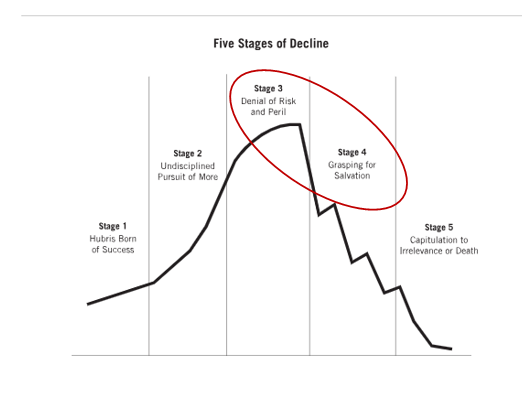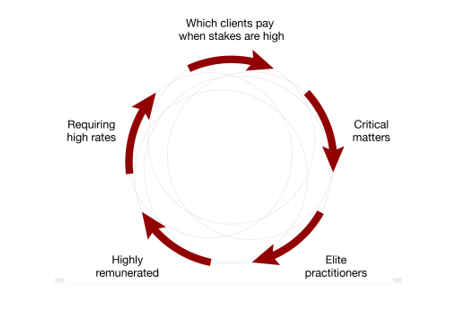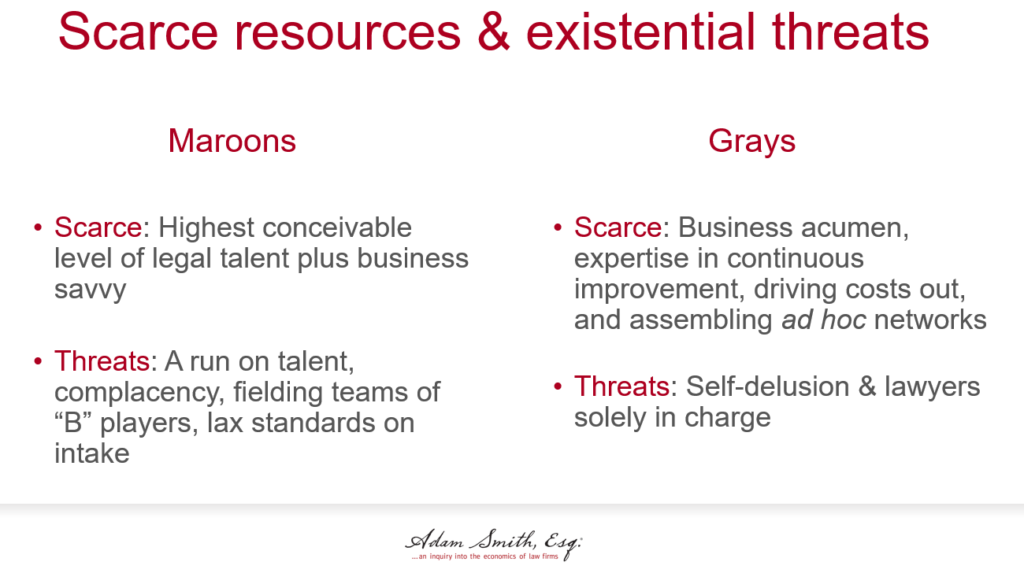It has been four years since we initially published our series laying out a law firm market segmentation model we called the “Maroons & The Grays,”[1] and four years on is none too soon for an update.
No model is, or should be, static, and as we have worked with and analyzed both “Maroon” and “Gray” firms over the years since publishing the original version of that segmentation model, we have realized it might be beneficial and edifying to delve more deeply into the strategic and operational ramifications for these firms.
Readers with a steel-trap memory may recall that we concluded our first discussion of the Maroon/Gray model with a simple two by two matrix mapping both sectors into well run and not so well-run segments:
The time has come to say a bit more about the priorities and risks for firms in each quadrant of this virtual matrix.
Two of the four quadrants are trivial to deal with, or to be slightly more charitable and less dismissive, not interesting enough to discuss in detail. They are the bottom left/SW quadrant and the bottom right/SE quadrants, poorly managed Maroons and poorly managed Grays. Why “not interesting?”
Sadly but realistically, business and organizational history is replete with stories of firms that have lost their way, never to recover. People have shown remarkable inventiveness over the years coming up with new ways to sabotage themselves and their organization. Here are a few:
- Cutting corners with the leading product or service,
- compromising standards and quality in less visible but ultimately unmistakable ways,
- betraying customer or employee trust,
- sloppy or crony hiring and promotion,
- elevating internal fiefdoms and turf squabbles over customer service[2]
- or simply shedding market share to newer and more capable competitors.
Whatever the proximate cause(s), once the slide has begun and disenchantment and demoralization have set in, the barriers to recovery and regaining the glory days are all but insurmountable. Indeed, the exceptions are so rare as to be celebrated in business literature—think Apple upon the return of Steve Jobs or Intel’s pivot under Andy Grove from commodity DRAMs to integrated microprocessors.
The widely read Jim Collins (Good to Great, Built to Last), known for his comprehensive examinations of businesses that have thrived, also published a slightly lower-profile book, How the Mighty Fall[3], which schematically outlines the five stages of decline in a memorable graphic:
 Whether the poorly run Maroons and Grays in the SE and SW quadrants are “denying risk and peril,” “grasping for salvation,” or on the verge of “capitulating to irrelevance,” they are, absent heroic actions, doomed to the margins. For our purposes, it doesn’t matter how they managed to navigate into this fix; there they are and recovering one’s esprit and relevance is beyond most mortals.
Whether the poorly run Maroons and Grays in the SE and SW quadrants are “denying risk and peril,” “grasping for salvation,” or on the verge of “capitulating to irrelevance,” they are, absent heroic actions, doomed to the margins. For our purposes, it doesn’t matter how they managed to navigate into this fix; there they are and recovering one’s esprit and relevance is beyond most mortals.
Let’s turn next to the well-run Maroons, in the top left/NW quadrant.
What do they need to do to remain on top of the prestige pecking order? In a word, quality across the board.
Quality is surprisingly simple to describe, if relentless and unforgiving to put into practice. Within the most elite precincts of BigLaw, quality is non-negotiable, period, full stop. In Econ 101 terms, everyone knows what a law firm’s “demand” is: Clients. But fewer people by far give any serious thought to what its “supply” is: It’s lawyers. Who better be impeccably credentialed, experienced, and hungry.
We developed this graphic recently to represent the “virtuous cycle” that law firms practicing at the highest altitudes of the profession live and die by.
It represents the circular logic that:
- Truly critical matters—rare events in the corporate lifecycle which command Boardroom level attention…
- …Demand elite lawyer/practitioners to address them…
- …Who will by the nature of competitive markets be highly remunerated…
- …Which is economically viable for the law firm only if it can command high rates for such work…
- …But/and which clients are more than willing to pay when the stakes are as high as, by hypothesis, they are in this model.
Maroons who lose sight of how all these elements interact and reinforce each other do so at their peril. Most importantly, and perhaps the two variables where the law firm has the most direct control, is to compromise on the quality of what it means to be composed only of “elite practitioners” or to compromise on client and matter intake, yielding to the temptation to take low-hanging revenue even if the matter is only of marginal, and not critical, import to the client.
- The gravity of the matters that the firm fits in the consideration set for is based on long-term cultivation of reputation,
- The incredibly liquid and transparent lateral partner markets guarantee remuneration will be market—competitive,
- High rates are both mandatory and desirable,
- And clients’ willingness to pay is so stipulated.
But law firms can break this virtuous circle and see themselves thrown off the super-affluent merry-go-round by fielding even one “B Team.” And, as we have all seen through the variously bitter and hilarious experience of high-profile politicians, executives, and others who have blown themselves up through ill-advised behavior, it can take a lifetime to earn trust but only a heartbeat to destroy it.
So as to quality and the Maroons I have little more to say. Compromise or be complacent about any of the reinforcing trends on the “virtuous cycle” at your massive peril.
This leaves the “Superb Grays”—the well-run Grays in the NE quadrant of the matrix. We describe it as “fascinating,” and “our favorite quadrant.” At the most generalized level, what distinguishes them from most Grays is two-fold: (1) They are run like businesses first and foremost; and (2) They are unsentimental about what that entails for traditions and customs viewed by many through the rosy haze of nostalgia.
As the attentive reader will know, the core competence of the Superb Grays is efficient, reliable, repeatable, high quality legal process optimization—“kaizen,” continuous improvement, relentless elimination of “defects” (variability in the results of the same process applied to the same basic set of facts), and increasing speed, all with lower costs over time. In other words, Superb Grays need to defy the cute engineering/management joke that “you can have it fast, cheap, or good—pick two.” Superb Grays need to deliver all three and improve their capabilities on this front continuously over time. The competition is moving, after all, and clients’ expectations rise accordingly.
Here’s the rub: Lawyers are not the ideal choice to manage these process optimization challenges. To the contrary, highly sophisticated (read: expensive) business professionals are the indispensable choice to be in charge of and advance this core competence of Superb Grays.
We noted in our original discussion of Maroons and Grays four years ago that a risk to Grays was “lawyers in charge,” and we stand by it. Lawyers will—and this is proper and essential—occupy key seats in firm management, but so will business professionals. Each group of professionals needs to do what they do best and leave the other group alone to do what they do best. Here’s our summary of the threats to Maroons and to Grays from our initial model four years ago:
The reflex assumption—it often does not even arise to conscious awareness-of “lawyer exceptionalism” goes roughly as follows: (a) lawyers can do anything at all—better than others; (b) but no one else can do what lawyers do; and (c) they can find fault with anything and everything. And we do not blame the lawyers for a moment; these traits (personality profiles sky-high in autonomy and skepticism) are remarkably effective and adaptive in serving clients. Clients want lawyers who take charge and can find holes in any argument.
Counter-intuitively, lawyers are also low on “resilience;” they do not recover gracefully from setbacks, but take them on the chin, stew, and are temporarily demoralized. Also, arguably, fine for client service: Losing should sting. But when it comes to firm management and operations, it would be hard to imagine three more maladaptive traits. The combination kneecaps experimentation and collaboration.[4]
We have no glib or snappy advice to offer in overcoming these “reflex” reactions by lawyers; they are doing exactly what they were trained to do.
But we will tell you that to achieve the high operational tempo required to be a Superb Gray, these traits need to be squelched. Our best advice in this situation—acutely aware that it’s easier said than done—is to paint a vision of what the firm needs to look like, where decision making needs to reside, and tirelessly communicate that vision and those priorities to everyone in the firm, from senior leadership to reception and back office functions.
The overriding goal is to install a commitment to a “one firm firm,” which goes hand in hand with “firm first” (not individual first). Presenting a vision, as vivid as you can make it, of how that will benefit everyone, is a core (internal) competence of a Superb Gray. At a high level, your vision needs to be inspiring (“what we are building here”), tangible, tailored to your firm and the antithesis of generic.
And one last thing: Repeat it relentlessly. We acutely recall chatting with a Managing Partner stepping down after a highly successful, even transformational, 15-year tenure, who had been pounding on this type of message for his entire term. Ruefully, he told us that a partner had come up to him after his valedictory speech and remarked on how impressed he was at the power and novelty of the MP’s key theme. “Well, thanks, but I’ve been saying it for 15 years.” “Really?! I never heard that before….”
And a final point from the perspective of market structure: Of all four quadrants, that of the Superb Grays is surely the most thinly populated. We hope we’ve advanced some of the reasons why in our discussion, but if you’re in a leadership position at such a firm, you should receive this as the greatest news in this entire essay.
- Your competition is sparse.
- It’s a difficult niche to occupy and an easy one to gradually slide out of.
- And most importantly, you are providing something of tremendous value to clients, with few if any substitutes of equal caliber.
Immediately upon our publication of the original Maroons & Grays model four years ago, law firms decided all but unanimously that they were, or wanted to be (and were so close to!) Maroons; the Grays, if you believed how people reacted, was a forlorn, lonely, and rapidly depopulating market segment.
We meant nothing of the kind. First and foremost, our goal was to describe and not to judge. We stressed in the first series of articles (insufficiently emphatically, we now realize) that both segments would and do contain firms that are succeeding and thriving and should in a rational world continue to do so. Likewise, of course, both segments contain lousy examples of the genre, whose future is cloudy at best.
Be that as it may, with this update we would urge the reader to take to heart our avowal that we find “Superb Grays” the most fascinating quadrant in that 2 x 2 matrix we kicked off this update with. And firms who excel under that business model should enjoy great financial success, growing prominence and the growing client base that should come with it, and challenging and rewarding work.
If you’re nervous about your firm’s current prospects analyzed through the lens of this updated model, and if that’s a quadrant your firm could plausibly navigate to, you really ought to check it out.
Good luck.
[1] See generally https://adamsmithesq.com/?s=maroons+grays
[2] I recently had to return a pair of shoes bought online and the retailer provided a prepaid FedEx return address label. At the nearby FedEx Office store where I went to drop off, the manager asked me, “What’s in the shoebox?” “Uh, shoes.” “Sorry, we can’t accept shoeboxes.” “But this is the box it was delivered in.” “Sorry, can’t take it.”
Turns out FedEx, but not FedEx Office, takes shoes in shoeboxes. True story.
[3] Jim Collins (Jim Collins Publishing: 2009), available at https://www.amazon.com/How-Mighty-Fall-Companies-Never/dp/0977326411/ref=sr_1_1?crid=C3NMY5PTHISD&keywords=how+the+mighty+fall+jim+collins&qid=1688510661&sprefix=jim+collins+h+ow+the%2Caps%2C93&sr=8-1.
For the diagram cited in the text, see https://www.jimcollins.com/concepts/five-stages-of-decline.html
[4] Lawyer personality traits vs. general white-collar professional US population relies on the work of Dr. Larry Richard’s experience with a sample of tens of thousands of lawyers administered the mainstream “Caliper” personality test, where scoring is indexed to a 0 to 100 scale, with 50 defined as the population norm. Lawyers average 93 on skepticism, 84 on autonomy, and 30 on resilience.




